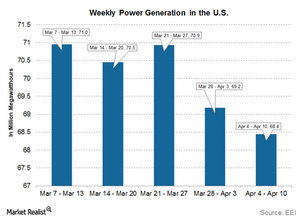US Electricity Production Falls for the Second Straight Week
Electricity storage is expensive. Most of the produced electricity is consumed instantaneously. As a result, electricity generation mirrors consumption.
April 21 2015, Published 2:36 p.m. ET

Electricity production falls
The EEI (Edison Electric Institute) publishes the generation data on a weekly basis with a one-week lag. The current report is for the week ending April 10. Electricity generation in the US dropped to 68.4 million MWh (megawatt hours) during the week ending April 10—compared to 69.2 million MWh for the week ending April 3.
The electricity generation was also lower than 69 million MWh during the same week last year. We’ll discuss the divisional breakup more in the next part of this series.
Why it’s important
Over 90% of the coal produced in the US is used for electricity generation. The Utilities segment is coal’s largest end user. As a result, coal and utility investors should watch for a trend in electricity generation.
Electricity storage is expensive. Most of the produced electricity is consumed instantaneously. As a result, electricity generation mirrors consumption.
What does this mean?
Thermal coal is mainly used for electricity generation. A decrease in electricity generation is negative for coal producers (KOL) like Peabody Energy (BTU) and Alpha Natural Resources (ANR)—keeping everything else constant. Also, in the current low natural gas price environment, natural gas may snap the market share from coal. It’s important to note that the weekly generation data is subject to seasonal aberrations. The impact on utilities (XLU)—like NextEra Energy (NEE) and Southern Company (SO)—depends on the regional breakup of electricity generation. We’ll discuss this more in the next part of this series.
